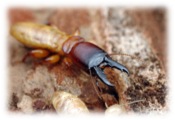The species Zootermopsis nevadensis belongs to the dampwood termites. The members of this species live in a piece of wood they also slowly consume. Sterile soldiers defend this “fortress” against intruders. Other non-reproductive members of the colony will eventually develop into adults that disperse to found new colonies. This is actually the only time, they would leave their nest. In contrast, mount building termites forage for food which they bring back to their colony to feed their brood.
Terrapon and collaborators sequenced the genome of this species and looked for genomic traces of sociality. This is especially interesting, since termites are only distantly related to the other major groups of eusocial insects that are found within the Hymenoptera (ants, some bees, and some wasps). Major changes in the genome have been found in genes relating to male mating biology and chemoperception. Termite societies consist of males and females in contrast to Hymenopteran societies that are entirely composed of females. While in the Hymenoptera, queens mate at one time in their live, termites form pairs of queens and kings that regularly remate. In Z. nevadensis, this is associated with cycles of testis activation and inactivation which may have required specific adaptations in spermatogenesis. The limited need for olfactory discrimination and communication due to the confinement to a single piece of wood is reflected in the low number of olfactory receptors needed for odorant perception. The results of this study were published in the May 20 edition of the journal Nature Communications in 2014.
